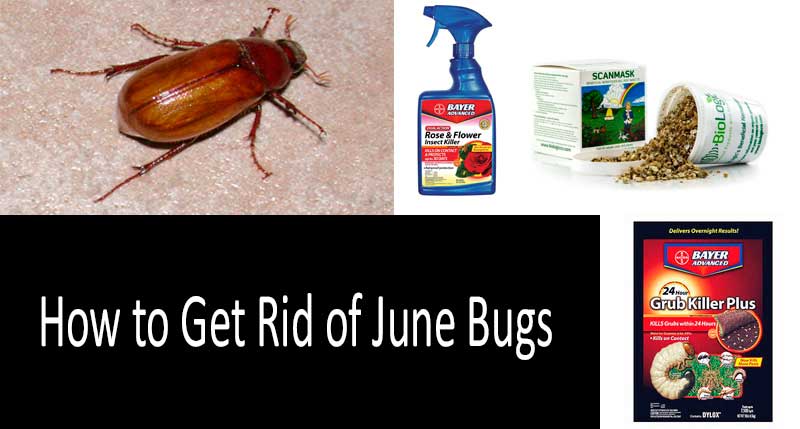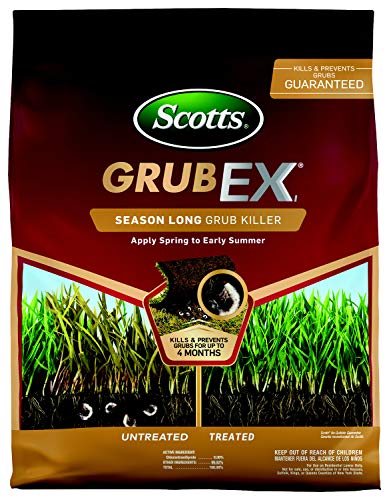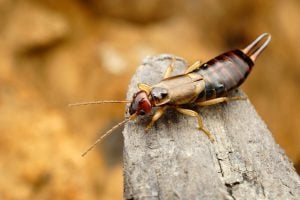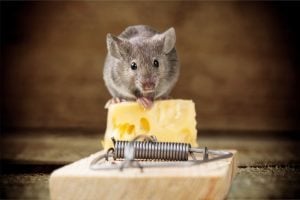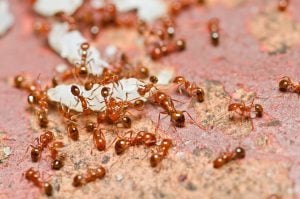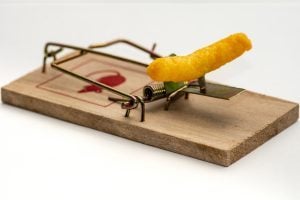I have fond memories of hot summer evenings as a kid in Texas. Riding bikes past sunset or sitting on the back porch waiting for a breeze. One constant, besides the humidity, was always being pelted by kamikaze June bugs. While us kids laughed at the leggy surprises, adult June bugs are voracious eaters of your favorite plants. The larvae are able to damage an entire grass lawn – in the South, well, you might as well move out of the neighborhood… Just kidding. Here you will find out everything about the most effective ways of getting rid of June bugs and their larvae. Get back your summertime backyard fun with one of our 9 best treatments.
Summertime is the time when June bugs or June beetles infest lawns, gardens, pastures and golf courses. They feed on the grass, fruit, vegetables, flowers and anything delicious. These insects are most fond of roses, vines and fruit trees. A single bug can keep coming to the same lawn for years, as a June bug’s lifespan lasts from one to four years, depending on the species. Over 200 species inhabit North America. Let’s learn about the behaviors and biology of this curious pest, how to best get rid of them and recommendations of the best treatments with maximum effect.
Contents:
Can a June Bug affect your yard all year long?
Besides getting pelted in the face by a random bug, what is most annoying is that June bugs damage plants as both adults and larvae. In the beginning, Larvae inhabit the soil and feed on the grass’ and shrubs’ roots causing the plants to wither and turn brown. Wilting from root damage can be observed in September. Adolescent bugs feed on the young and gentle leaves of decorative plants, fruit trees and crops grow from May till August. During warm summer, the larvae hatch from the eggs and eat plant roots until they hibernate in winter deep underground. If we compare larvae and adult June bugs, we will see that the larvae cause greater damage to the yard as they can devastate smaller plants by destroying their roots. This should be considered when devising a strategy of protecting your plants from pests.
What do they look like and will they hurt me?
As a rule, June bugs are red-brownish or black and their length does not exceed an inch. Adult bugs’ activity reaches its peak after dusk in the end of May and beginning of June. You have probably seen them bump into the windows, as June bugs are attracted by light but are clumsy fliers. June bugs are not aggressive or dangerous for people. Do not worry that these insects will bite you or harm you in some other way. A younger version of myself would like to be reminded to ride my bike with my mouth closed!
The first thing you should start with is developing a plan of action. Here is the list of steps that you may find helpful:
Search for larvae as they will soon develop into adult June bugs. The dead grass is the best indicator of the larvae presence. Remove a section of it and look for C-shaped grubs. It is much easier to destroy June bugs at this stage of their life cycles.
In case there is no heavy infestation, take a preventive approach. This involves using insecticides with imidacloprid, halofenozide and some other compounds as active ingredients. They are less toxic and can be applied whenever you want but kill larvae only. The only condition is that the grass should be green.
If you have detected over a dozen of grubs, it is too late for prevention. Therefore, fast-acting solutions are needed. Insecticides containing carbaryl and trichlorfon will eradicate larvae over the course of half a month. These insecticides work on adult June bugs as well. However, such products are toxic and affect beneficial insects as well.
If you want to avoid treating the soil and plants with strong chemical, natural solutions can be applied. These are natural enemies of grubs, such as nematodes. They are commercially available worm-like creatures which are sprinkled on the soil. Then, nematodes do their job by hunting larvae and infecting them with lethal bacteria. Another natural larva killer includes insecticides containing the neem oil making the insects unwilling to eat and lay eggs. Neem oil targets both larvae and adults.
Set traps to reduce June bug population and preventing the new ones. June bug traps can be homemade and easy to use. Fill as many jars as possible with soapy water and set them under the plants preferred by June bugs. The insects will drop there and unable to climb out.
Install bug zappers. LED bulbs of these devices will attract June bugs into the electric grid where the captured insect will be electrocuted. June bugs are big, that is why you should select large-size zappers. Eco friendly and entertaining – what could be better!
Take advantage of June bug natural enemies such as birds and frogs. While frogs are available in specialized shops, birds can be attracted by means of constructing bird nesting box or feeder.
What makes a plan effective? Proper implementation. Therefore, the SPI Research Team recommends that you keep reading our detailed guide on scientifically proven methods of killing June bugs, both at the adult and larval stages. Also, look at a review of the TOP 9 best products popular with customers.
While applying pesticides on the soil surface is useful against larvae, you can get rid of adult June bugs by using the pesticides for the leaves they feed on. This effective measure won’t last long if it rains heavily, so you should also use other options, such as bug traps. Moreover, proper irrigation and fertilizing minimizes the damage caused to the leaves.
In order to figure out whether these insects will harm your lawn and to take timely counter-measures, observe your area. Have any June bugs ever appeared and have there been many larvae? P.J. Liesch, UW-Madison Entomology advises: “In locations where damage from a large population has occurred, control may not be warranted every year due to the multi-year life cycle of May/June beetles. Knowing the history of May/June beetle damage in your area and monitoring for these insects can go a long way towards predicting damage and effectively managing this pest.”
Remember that adult bugs not only feed on the leaves, they also lay larvae that will soon damage the roots of plants and grass. Adult females can lay up to 62 eggs on favorable moist soil, and only ten active larvae will make the grass wither.
For Quick Results, Use Chemicals
Contact insecticides will let you get rid of June bugs quickly. These products contain carbaryl, cyfluthrin, lambda-cyhalothrin and other substances. Sevin and Bayer brands contain carbaryl, which is the most popular insecticide for these purposes and used to treat different kinds of insects. It is applied on the plants which adult June bugs eat.
Although this chemical is relatively safe, you should be extremely cautious when applying treatment containing it and follow all of the instructions. Moreover, carbaryl is extremely toxic for many useful insects, such as bees, so try to apply as few of such insecticides as possible on blossoming plants. If it is impossible to avoid using it, use it in the evening when the bees’ activity slows down.
Cyfluthrin is known for its light-resistance and long residual effect. Tempo, registered by the EPA, contains this ingredient. Guido Schnabel, Professor of Plant Pathology, Dept. of Agricultural and Environmental Sciences, also recommends Bonide containing lambda-cyhalothrin. This chemical substance resembles pyrethrin-based insecticides with better characteristics. For more details, scroll down to the list of the top 9 best June bugs killers.
For Natural Treatment, Set the Traps or Get Some Frogs
Set special traps to substantially reduce the number of June bugs that can lay eggs on your lawn. Such traps are available in stores or can be handmade. How do you make them?
Homemade June bug trap. Fill a jug or any other container with a few inches of vegetable oil. Place several such jugs along the perimeter of the lawn near the plants that the bugs feed on. Dig a hole deep enough to only see the jug’s neck. Set bright white light with mercury lamps, for instance, over the container to attract the June bugs’ attention. As the scientists have discovered, it is the incandescent bulb that attracts most insects (about eight individuals per hours). Do not use yellow lighting as June bugs hardly notice it. Once the bugs fly to the light, some of them will fall into the jugs. Make sure you remove dead bugs from there each or every other day by sifting its contents. The actual making of this trap can vary. For instance, you can use a basin with soapy water or children’s inflatable water pool for this purpose.
You can also attract birds and frogs as they will find and eliminate pests on their own. Both birds and frogs consume larvae and adult June bugs. Birds can be attracted by building feeders and birdhouses while frogs can be bought at a local animal store. Frogs are considered to be most effective because they are most active at night, just like June bugs.
As we’ve already mentioned above, it is not adult June bugs, but their larvae that cause the most damage as they feed on the roots and can harm the entire lot. First, estimate whether you need to use any treatment. Remove the upper soil layer covered by the yellow grass. If you find at least 10 larvae there, it is high time to use pesticides or natural treatments. Fewer larvae shouldn’t worry you as just a few of them cannot damage your lawn.
The second step is to determine the approach you will use. If you’ve decided to go with the chemicals, you will have to choose whether to use curative or preventive methods. The Curative method implies using the treatments containing such active ingredients as carbaryl, clothianidin and trichlorfon and will destroy larvae within two weeks and cause harm to other useful insects. Moreover, these chemicals are rather toxic. Chlothianidin, in particular, is gentler, but its effect is seen only after 10-14 days. The preventive method is more effective, but its disadvantage lies in the fact that it will yield results slowly (a year or even a few). In return, your efforts will be rewarded ensuring protection and near 100% pest removal while the curative method only provides 77% bug removal. The Michigan State University Extension specialists recommend using preventive methods for getting rid of future larvae generations.
If you have decided to opt for the recommended Preventative method, use Merit, MachII and GrubX containing imidacloprid, thiamethoxam, halofenozide, clothianidin or chlorantraniloprole. The latter ingredient is known to be low toxic and convenient to use. A treatment that contains it can be used at any time once the grass is green – Mid Spring is best to make the application effective for the hatching larvae. REMEMBER: DO this every spring for long term results.
Please avoid chemicals containing only such active ingredients as lambda-cyhalothrin, bifenthrin, cyfluthrin and permethrin. These substances only act against adult June bugs feeding on the surface of the soil and not their larvae.
Natural larvae treatments have lately become increasingly popular. Although such products are inferior to chemical ones in terms of their effectiveness, they have some indisputable advantages, namely environment-friendliness and safety. Using nematodes is one of the most effective natural methods. They are worms that are to be placed into the soil that will infect larvae with bacteria and thus kill the pests. Nematodes are available in stores in packs containing up to 10 million worms. Remember that two types of nematodes are sold: Heterorhabditis bacteriophora and Steinnernema glaseri (aka S. carpocapsae). The former are more active, they follow the larvae and can descend deeper underground. The latter wait for their victim and do not stray far from the surface of the soil. For this reason the scientists consider Heterorhabditis bacteriophora to be a more effective treatment.
Another method involves using a natural insecticide, neem oil, an ingredient that is found in an evergreen Indian tree. Larvae perceive it as a natural hormone and consume it. Neem oil acts by blocking real hormones, making the larvae quit eating and laying eggs. For more details, refer below to our list of the top 9 best June bug larvae killers.
A Comparative Review of Methods of How to Get Rid Of June Bugs & Larvae (Grubs)
Effectiveness Ratings 1-10: 1 being the worst and 10 being the best.TOP-9 June Bugs & Larvae Killers
We’ve found the nine best treatments recommended by the scientists. Five of them are killers for adults (bug zappers and insecticides for treating the leaves that the June bugs feed one), and the other four are aimed at eliminating the larvae. There are both natural neem oil-based ones and powerful insecticides. They all work – your job is to pick the best one for your situation and commitment level. Our best advice is to make a plan and take action – even if that means getting the product now, storing it in the garage and setting yourself a reminder for next spring to treat the lawn.
1. Bayer Advanced 502570 Dual Action Rose and Flower Insect Killer Ready-To-Use, 24-Ounce
Its active ingredient cyfluthrin kills adult June bugs and imidacloprid has preventive properties. It kills on contact and protects you for a month. It is very convenient that the product can be applied regardless of the weather as it is rain-proof within an hour after application. It is perfectly suitable for home plants but should still be used outdoors. The product helps to get rid of various insects, but at the same time, it can be dangerous for pet reptiles and other pets, so make sure they stay away from the treated territory,
This highly rated product is versatile and best applied to your favorite bushes with the hand sprayer a preventative. User success is found through applying it every month or 2 from Spring through Summer. Keep in mind this is not a yard and grass treatment but will keep your favorite plants looking great all year long.
Price: Check the current price
2. Bonide 195 Beetle Killer, 32-Ounce
This spray not only kills June bugs quickly, but also has repelling properties as it scares off the insects for eight weeks after use. It acts against both June bugs and other pests, such as Japanese beetles and Colorado potato beetles. It does not leave any stains and does not have a strong odor. Thanks to its convenient and powerful adjustable spray, a tall tree can be sprayed.
This spray only acts against adult June bugs and its active ingredient is lambda cyhalothrin. It can be applied on edible plants. Consider it a powerful ally in your multi step approach in protecting your plant babies.
To avoid negative experiences by other users, try timing the spray when you just start to see the beetles flying around in the evenings and stay consistent through out the summer and consider preparing for a larval yard treatment next spring.
Price: Check the current price
3. Garden Safe Neem Oil Extract Concentrate (16 fl oz)
A natural and affordable neem-oil based treatment. This product kills eggs, larvae and adult June beetles. It is safe and can be applied on vegetables, fruit, flowers and shrubs but is not recommended for plants with gentle or withering leaves. Garden Safe Neem Oil Extract Concentrate contains an insecticide, a fungicide and a miticide so it is extremely cost-efficient. Its active ingredient, neem oil extract, blocks larvae’s hormones and makes the insects quit eating and laying eggs, eventually causing them to die. The treatment effect will be observed in the long run, not instantly. It is recommended to apply the concentrate once a week or a fortnight late at night or early on the morning.
Many have experienced positive results using this spray on their precious herbs and tomatoes. It is a concentrate so make sure you have a high quality sprayer available. To avoid negative experiences with this product be ready to spray regularly – remember, the beetles have to actually eat it to get sick.
Price: Check the current price
4. Bayer Advanced 700740S 24 Hour Grub Killer Plus, Granules
If you would like to speed up the process and remove larvae faster, use Bayer Advanced granules with the active ingredient trichlorfon. The manufacturer promises that the product will help remove pests over an area of 5000 square feet within 24 hours.
However, in this case, you will be dealing with a less safe product. Moreover, trichlorfon use is restricted in a number of states. The treatment cannot be used in the kitchen garden or on edible plants, fruits and vegetables. Also, avoid getting the substance onto the flowers’ leaves.
64% of users gave five stars to this product, while 11% only awarded it with one star. Here is what one the users commented: “The 24-hour Bayer kills grubs which is the best of the grub products that I’ve used. Best time to do this is end of August or early September.”
Price: Bayer Granules Check the current price
5. Scotts GrubEx, 5,000-sq ft against Larvae
This product’s active ingredient is chlorantraniliprole. Use it if you opt for a preventive approach. It acts for four months and can cover up to 5000 square feet.
Spray the lawn in the spring or at the beginning of the summer and irrigate the soil well to activate chlorantraniliprole. This is one of the safest preventive soil treatment ingredients. Allegedly, it does not do any harm to useful insects, although some users disagree: “It may damage some but not all of the earthworms. But it’s a whole lot better than your whole lawn getting eaten up”, says one of the customers. Half of the users gave five stars to this product. Moreover, remember that Scotts GrubEx is banned for use in the state of New York.
Price: Check the current price
6. Dr. Pye’s Scanmask 10 Million Live Beneficial Nematodes
Steinernema Feltiae nematodes are a natural way of getting rid of larvae. They don’t kill useful bacteria and only remove larvae. These worms are sold in special shops. Before you let them into the soil, water it well and repeat once the nematodes enter the soil. You will only yield Steinernema Feltiae’s activity results after several months. These nematodes act on a 200 square feet area.
As we have already explained, Heterorhabditis bacteriophora nematodes-containing treatments are more effective than the ones with Steinnernema. Pay attention to another product, 10 Million Live Beneficial Nematodes Hb – Soil Pest Exterminator, containing Heterorhabditis bacteriophora. The same number of worms are able to cover up to 3000 square feet for a lower price.
Price: Beneficial Nematodes Hb Check the current price
Dr. Pye’s Scanmask’s competitive edge lies in the fact that it affects more insect species, namely 23, which is more than the other product can offer. users also rate Steinnernema quite high as 55% of them awarded five stars to it versus 48% of five-star ratings to the other treatment. One of the users noted: “This is the third year for our 3,000 SF organic garden and all of the crops are healthier than they have been in the past.”
Price: Dr. Pye’s Check the current price
How to Get Rid Of June Bugs At Night
There exist various bug zappers: they are small and stylish, just like the light bulb below, but they are only suitable for small insects. In our case, more powerful indoor and outdoor devices, such as the bestselling Flowtron Zapper and Insect Killer by Aspectek, are required for large June beetles.
7. Flowtron BK-15D Electronic Insect Killer, 1/2 Acre Coverage – Best Selling Bug Zapper for Outdoor Use
Here before you is an absolute bestseller among the Bug Zappers. This device has over 7500 customer reviews left by those whom Flowtron helped remove various insects including June bugs, moths, biting midges and others. It is powered from an outlet and its blue light attracts the insects. Once they fly closer, they touch an electric grid which electrocutes them. It is safe for people as the grid is covered with a plastic carcass, but it is still better to use it at least 25 feet away from people. If you approach too close, the insects’ attention will switch from the gadget to you. Moreover, when roasted, parts of insects can fly far away from the device, which is not very pleasant.
Flowtron is for outdoor use only and can cover up to ½ of an acre. It works best in the dark near shrubs and trees in calm weather. You will have to regularly remove dead insects from the grid. Turn the zapper off before you do this. Clean with a brush, small air compressor or an air can duster.
The only thing the users are unhappy with is the power cord length (1/2 foot), so you will definitely need an extension cord. Some home owners also claim that their June bugs were so large, they had to remove a couple of plastic carcass’ ribs to let the bugs reach the grid closer. Read over 10 000 reviews to learn more life hacks from other customers.
Price: Check the current price
8. Bug Zapper & Electric Indoor Insect Killer by Aspectek – For Indoor Use
If a cute but small light bulb indoor zapper does not seem reliable against home bugs, check out Bug Zapper & Electric. The device is scientifically proven to radiate 365 nm wavelengths attracting the insects. Once attracted by the light, the bugs are electrocuted by the electric grid. The manufacturer claims that this 2800V bulb killer is the most effective one on the market and guarantees best results.
Unlike the previous light bulb, Bug Zapper & Electric is for indoor use only. A special chain for hanging (and not only placing on the surface) the gadget is supplied. The device’s dimensions are 15.5 x 12.4 x 3.9 inches, it is easy to use, requires no maintenance apart from removing the dead insects from the bottom tray.
Users have rated the product highly as 81% of them awarded it with a five star rating. One of the buyers commented: “My wife bought this to get rid of these annoying little flying bugs. She loves it and she said it really works. We keep hearing loud zap in our apartment. I will definitely recommend.”
Price: Check the current price
9. Bug Zapper night light Dual Bright LED Light Bulb Mosquito Zapper Zapplight
This trap is a great invention allowing us to get rid of the annoying bugs without resorting to chemicals and to reduce their population on your lawn. Moreover, Bug Zapper can also protect you from mosquitoes.
The trap has day and night modes. An LED bulb will light your home or terrace at night and the blue light will attract the insects to the bug-zapping grid. It is convenient and safe for use and easy to clean, as a special brush is supplied. Moreover, it is essential that the device is energy-saving.
Most of the users approve of the gadget, although almost 20% only gave Bug Zapper one star. The device has its drawbacks. Although the trap is not intended for indoor use only, and can be used outdoors, it shouldn’t get wet – this seems to be a problem outside.
One of the users gave feedback on their purchase: “Mine is in the laundry room. I have a mess screen on door to patio and people are in and out all day. I have noticed a large drop in the amount of bugs that make it past, day and night.” Another user was not satisfied with the performance of this device as a bug trap: “Light works and the bug zapping light is cool looking but I have yet to hear it zap any bugs.”
Price: Check the current price
The Best June Bugs & Larvae Killers: Comparative Chart
| Product | Stage | Type and Peculiarities |
| Bug Zapper LED Light Bulb | Adult June Bug | An LED-lamp trap for indoor use. |
| Bug Zapper & Electric Indoor Insect Killer by Aspectek | Adult June Bug | Indoor use 2800V lamp bug zapper. |
| Flowtron Electronic Insect Killer | Adult June Bug | A best-selling bug zapper for outdoor use only. |
| Scotts GrubEx | Larvae | Chemical treatment with the active ingredient chlorantraniliprole, is a preventive measure. |
| Bayer Advanced 700740S | Larvae | Chemical treatment with the active ingredient trichlorfon, is a curative measure. |
Dr. Pye’s Scanmask 10 Million Live Beneficial Nematodes  Check Price | Larvae | Natural killer Steinernema Feltiae nematodes. |
Garden Safe Neem Oil Extract Concentrate  Check Price | Larvae, Adult June Bugs | Natural killer with the active ingredient neem oil. |
| Bayer Advanced 502570 Dual Action Rose and Flower Insect Killer | Adult June Bug | Chemical treatment with the active ingredient lambda cyhalothrin. |
When and How to Apply Adult June Bugs & Larvae Treatment
The success of the treatments depends on timely use of curative and preventive methods. Thus, these methods needn’t be used in the spring as you won’t achieve the necessary results at that time. At this time, the existing larvae are too big, and the new ones haven’t hatched yet. The fall is also unfavorable as larvae become large enough by mid-September. Curative methods should be applied in summer (mid-August) when the insects haven’t developed yet and are located near the soil surface. Preventive methods are to be used mid-June or mid-July before the pests hatch.
Irrigate the soil well before and after treatment. This is also valid for applying natural products, such as nematodes. Coffee cups will help you determine the amount of water required. Place them on the loan and turn the sprayer on. Once the cups are an inch filled with water, the soil is moist enough.
Before you use any treatment, make sure you read the entire manual by the manufacturer. Remember that insecticides require caution, so buy just as much as you need and never flush unused substances down the toilet, drain or water source. Treat the soil with any leftovers and never leave the products on the pavement or any other solid surface. Don’t use them when it’s windy. Only enter the treated lot after the substance has been applied on the grass and leaves have dried.

